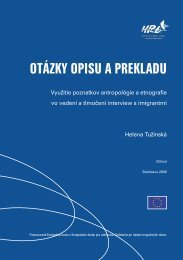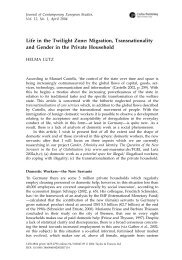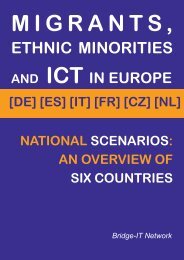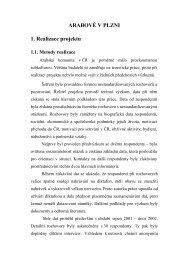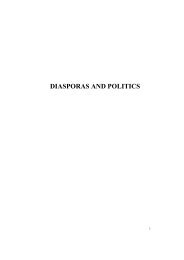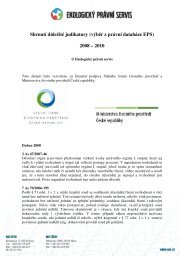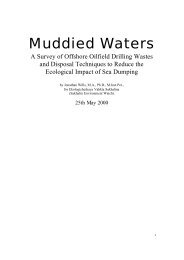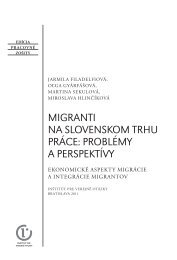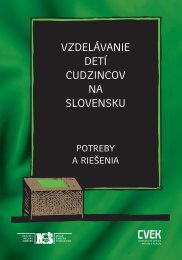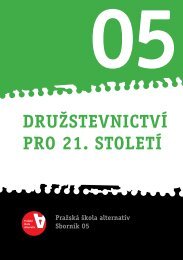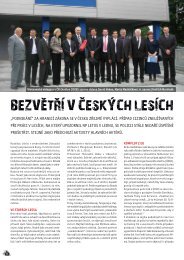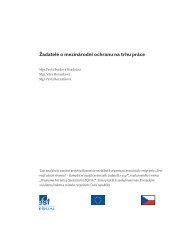Migration Processes in Central and Eastern Europe - Multiple Choices
Migration Processes in Central and Eastern Europe - Multiple Choices
Migration Processes in Central and Eastern Europe - Multiple Choices
You also want an ePaper? Increase the reach of your titles
YUMPU automatically turns print PDFs into web optimized ePapers that Google loves.
———————————————————————————————————————————————————————————————<br />
Construction of Borders <strong>and</strong> Practices of Labour <strong>Migration</strong><br />
———————————————————————————————————————————————————————————————<br />
S<strong>in</strong>ce 1993, a lot of travel agencies <strong>and</strong> <strong>in</strong>termediaries<br />
provid<strong>in</strong>g visa services for certa<strong>in</strong> countries appeared.<br />
In exchange for a certa<strong>in</strong> amount of money, depend<strong>in</strong>g<br />
upon dest<strong>in</strong>ation, they procure the “visa” <strong>and</strong> all the necessary<br />
documents for the future migrants. A migrant spends<br />
on average 658 USD for migration (CBS-AXA, 2005:13).<br />
Usually the visa is issued for tourist purposes <strong>and</strong><br />
therefore, after its expiry, the migrant's stay <strong>in</strong> the dest<strong>in</strong>ation<br />
country becomes illegal. There are cases when<br />
migrants are provided with false visas or passports. Almost<br />
40,000 persons of Moldovan citizenship are apprehended<br />
each year whilst illegally either attempt<strong>in</strong>g to cross an<br />
<strong>in</strong>ternational border or resid<strong>in</strong>g <strong>in</strong>side a <strong>Europe</strong>an country<br />
(ICMPD, 2004: 6). Illegal (irregular) migrants apprehended<br />
by border police are usually deta<strong>in</strong>ed <strong>in</strong> special centres until<br />
a sentence of conviction is issued by the court, usually for<br />
illegal cross<strong>in</strong>g of the state borders or/<strong>and</strong> forg<strong>in</strong>g of<br />
official documents. The ludicrous th<strong>in</strong>g about this situation<br />
is that people pay thous<strong>and</strong>s of Euros to get <strong>in</strong>to “Fortress<br />
<strong>Europe</strong>” <strong>and</strong> then they truly do end up <strong>in</strong> prison.<br />
Mass emigration <strong>and</strong> its consequences have<br />
become a serious problem <strong>and</strong> challenge for Moldova. The<br />
prelim<strong>in</strong>ary results of the 2004 National Census showed<br />
that 259,554 people left the country. Another recent study,<br />
<strong>Migration</strong> <strong>and</strong> Remittances <strong>in</strong> Moldova, estimated on the<br />
base of remittances that the number of migrants is<br />
567,000. The same study shows that 31.8 percent of<br />
migrants are with<strong>in</strong> the EU (CBS-AXA, 2005). Unofficial<br />
sources <strong>in</strong>dicate a range from 600,000 to 1 million<br />
migrants.<br />
It is argued that crim<strong>in</strong>al organised groups have<br />
taken advantage of poor migration management <strong>and</strong> developed<br />
extensive networks of traffick<strong>in</strong>g <strong>and</strong> smuggl<strong>in</strong>g.<br />
The traffick<strong>in</strong>g of human be<strong>in</strong>gs from Moldova to Balkan<br />
countries started <strong>in</strong> the beg<strong>in</strong>n<strong>in</strong>g of the 1990s, but the<br />
problem only appeared on the political agenda at the end of<br />
the decade after pressure from the <strong>in</strong>ternational community.<br />
The latest cases show that traffick<strong>in</strong>g from Moldova has<br />
changed its direction towards Russia, United Arabian<br />
Emirates, Israel, Turkey, Cyprus, Pol<strong>and</strong> <strong>and</strong> to a smaller<br />
extent towards Western <strong>Europe</strong>an countries.<br />
When discuss<strong>in</strong>g Moldovan border issues, dual<br />
Moldovan-Romanian citizenship cannot be ignored.<br />
Moldovans can acquire Romanian passports if they can<br />
prove that their parents have lived on Romanian soil. With<br />
the future accession of Romania to the EU, the acquisition<br />
of Romanian passport has become much more desirable;<br />
at least 500,000 Moldovans currently have dual citizenship<br />
(UNDP, 2005: 127). The consequences of this process are<br />
hard to predict, but if there is mass emigration of<br />
Moldovans, it will not be possible to differentiate between<br />
Romanians on one side of the river Put <strong>and</strong> on the other.<br />
•• Moldovan-Ukra<strong>in</strong>ian border<br />
The second type of border is the Moldovan-<br />
Ukra<strong>in</strong>ian border, which is less managed than the one<br />
between Moldova <strong>and</strong> Romania. This is <strong>in</strong> part due to the<br />
fact that it used to be an <strong>in</strong>ternal border dur<strong>in</strong>g Soviet<br />
times. A border treaty was signed <strong>in</strong> 1999 but it was as late<br />
as 2001 when it entered <strong>in</strong>to force, proclaim<strong>in</strong>g the border<br />
between Moldova <strong>and</strong> Ukra<strong>in</strong>e as an <strong>in</strong>ternational border.<br />
This border regime is more unorganised than the one<br />
between Moldova <strong>and</strong> Romania. Besides the legally<br />
established BCPs, there are secondary pathways that are<br />
not controlled by competent bodies. Thus, the border<br />
provides only a limited obstacle to people who <strong>in</strong>tend to<br />
cross the border illegally. Tak<strong>in</strong>g <strong>in</strong>to consideration that the<br />
Ukra<strong>in</strong>ian borders with Russia <strong>and</strong> Belarus are also porous,<br />
people <strong>and</strong> goods from the CIS may cross the eastern<br />
border of Moldova practically without control.<br />
•• “One <strong>and</strong> a half” borders with Transnistria<br />
The major problems, however, exist on the<br />
Transnistrian sector of the Moldovan-Ukra<strong>in</strong>ian border.<br />
For almost fifteen years this stripe of l<strong>and</strong>, that covers 421<br />
km <strong>in</strong> length (other sources <strong>in</strong>dicate 470 km ) with eleven<br />
important cross<strong>in</strong>g po<strong>in</strong>ts along the border have been out<br />
of access for Moldovan border guards <strong>and</strong> customs. The<br />
lack of government control with<strong>in</strong> this region has made it<br />
the “black hole of <strong>Europe</strong>” <strong>and</strong> a safe haven for all k<strong>in</strong>ds of<br />
illegal activities (CESS, 2004). The territory's dubious stage<br />
can be demonstrated us<strong>in</strong>g a number of facts: accord<strong>in</strong>g<br />
to a recent Moldovan publication, one third of firearms<br />
confiscated <strong>in</strong> Ukra<strong>in</strong>e <strong>and</strong> 83 percent of the total volume<br />
of narcotic raw material delivered to Ukra<strong>in</strong>e come from<br />
Transnistria (IPP, 2002). In the territory controlled by the<br />
separatists there is a massive contrab<strong>and</strong> of cigarettes,<br />
alcoholic beverages <strong>and</strong> oil products. Transnistria is also<br />
an important station for the bus<strong>in</strong>ess of traffick<strong>in</strong>g women.<br />
A large number of women from Russia, Belarus <strong>and</strong> Ukra<strong>in</strong>e<br />
are trafficked via Transnistria, Moldova, Romania, <strong>and</strong><br />
Cyprus to Western <strong>Europe</strong>. The half border between Moldova<br />
<strong>and</strong> Transnistria is controlled by the so-called Transnistrian<br />
authorities; Moldova did not establish any checkpo<strong>in</strong>ts<br />
s<strong>in</strong>ce this stripe of l<strong>and</strong> is viewed as part of the country.<br />
No visa is required for Moldovans from the right bank of<br />
Nistru when enter<strong>in</strong>g Transnistria, but an entry fee of 50 US<br />
cents has to be paid to the Transnistrian border guards.<br />
BORDER ENFORCING PROJECTS AND MEASURES<br />
The pro-<strong>Europe</strong>an turn of events <strong>in</strong> Ukra<strong>in</strong>e signalled<br />
by the new leadership represents a possibility for strengthened<br />
cooperation between the two countries, especially on<br />
Transnistrian <strong>and</strong> border issues. One of the measures to be<br />
undertaken is the creation of jo<strong>in</strong>t border cross<strong>in</strong>g po<strong>in</strong>ts.<br />
31<br />
<strong>Migration</strong> <strong>Processes</strong> <strong>in</strong> <strong>Central</strong> <strong>and</strong> <strong>Eastern</strong> <strong>Europe</strong>: Unpack<strong>in</strong>g the Diversity



